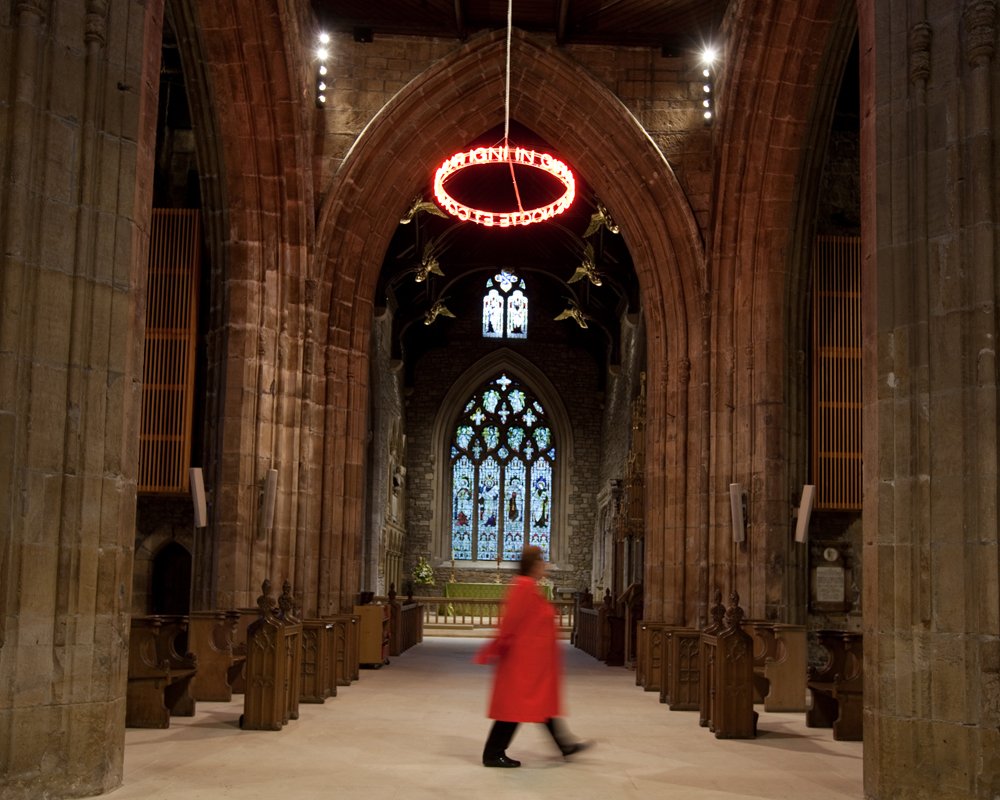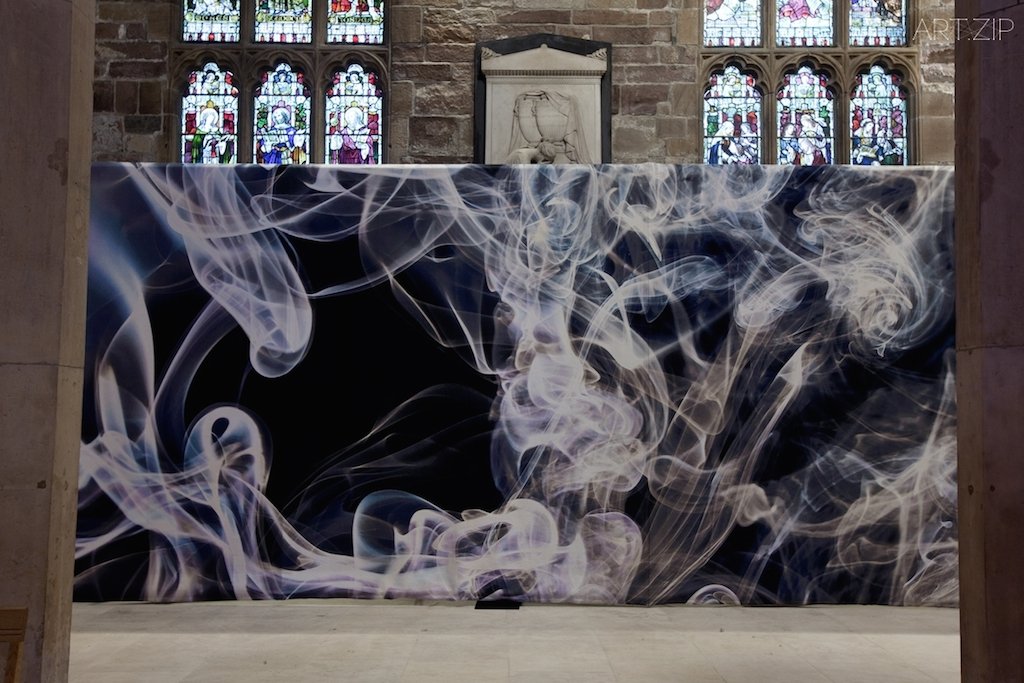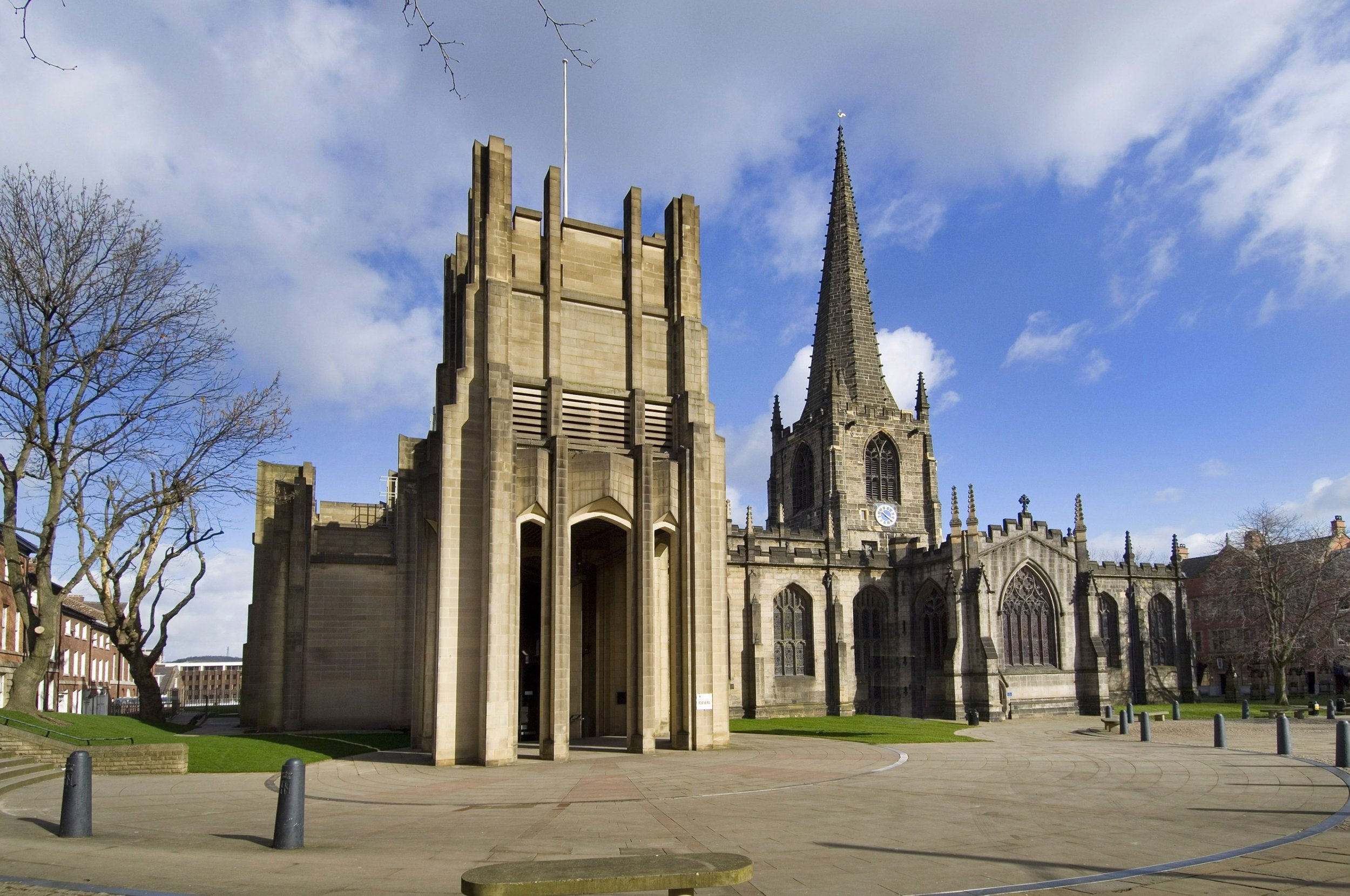Sheffield Cathedral
Exhibition in Citywide Event Showcasing Works from Private Collections
In the autumn of 2015, Sheffield Cathedral took part in ‘Going Public: International Art Collectors in Sheffield’, a collaborative project which saw the city working in partnership with European art collectors to showcase highlights from several private collections across five venues across the city. In addition to the Cathedral, the Millenium Gallery, Graves Gallery, Site Gallery and Sheffield Institute of Arts Gallery hosted temporary exhibitions. The work on display at the Cathedral came from the Sandretto Re Rebaudengo Collection and comprised of works that speak to social and political topics relevant to contemporary life. By hosting loaned artworks by leading artists, Sheffield Cathedral created a dialogue between sacred space and contemporary art. In addition to the exhibitions, a summit with leading thinkers, professionals and philanthropists was convened at Sheffield Hallam University and the Cathedral, the aim of which was to inform the development of a new framework for building greater support for the visual arts beyond the major cultural capitals.
Peter Bradley, the Dean of Sheffield Cathedral, aimed to select works that would be relevant to the community as well as work in dialogue with the religious setting of the Cathedral.
‘Many cathedrals commission pieces of contemporary music or significant pieces of contemporary art and we wanted to take that dialogue a little bit further and consider whether art, that is in no way conventionally Christian, can speak in a Christian environment in a new way.’ The Very Rev’d Peter Bradley
Sebastien Montabonel, a specialist in contemporary art working on the project commented:
‘One of the goals was to connect to the local community … and open [the Cathedral] up to a broad range of people who might not otherwise encounter this art.’
In a scarce arts funding climate, finding ways to make art accessible to the public in new ways is challenging. The conversations generated by ‘Going Public’ and the involvement of private collectors were rewarding ones for those involved in the visual arts in Sheffield. The exhibition also made the public aware of the Cathedral as an art space; one for learning, where challenging ideas could be explored.
‘I’ve lived in Sheffield for more than 30 years and I think you can count the times I have been into the cathedral on one hand! To bring all that interesting and high quality work into the city was great, and it was really effective in bringing people into spaces that they might not usually go to.’ Tim Etchells, Artist
The exhibition also had an impact on the Cathedral staff and congregation; Rev’d Bradley commented that the exhibition increased the confidence of the Cathedral guides, and that the congregation took great pride in their Cathedral, having seen what remarkable things their community was capable of.
The Cathedral Church dates from around 1430 although the building has been considerably enlarged since its cathedral status was declared in 1913. The site retains more of its medieval heritage than many churches while including some contemporary additions such as the lantern tower’s stained glass design by Amber Hiscott (installed in 1999).
The exhibition took four years of planning including the time spent liaising with collectors and applying for funding. The Cathedral showcased ten multimedia artworks including Douglas Gordon’s A Divided Self (I and II), (1996) Maurizio Cattelan’s 20 Christmas 95 (1995); and Jake and Dinos Chapman’s Cyber Iconic Man (1999). Works exhibited brought the violence of the contemporary world into the Cathedral, for example former Turner Prize nominee Goshka Macuga’s Plus, Ultra (2009) a large tapestry showing drowning African migrants, the Twin Towers and the G20 leaders, which hung in the nave. Rev’d Bradley commented to a BBC reporter:
“A lot of classic religious art shows images of really rather frightening violence, [such as] the crucifixion. But we don't notice that because we don't actually see it as violence. We see it purely as an illustration of a story. Some of these artworks invite us to reflect on violence, and violence in a religious context, in a new way, and that's strong, certainly."
Description
The idea for the project initially emerged as a response to cuts in arts funding to the region. Sheffield as a city had to find ways to increase its impact in the arts without incurring significant costs. The total cost was around £250,000 largely because the dealers and art buyers did not take a commission or look for payment. In addition, most collectors paid for the transport and installation/deinstallation of their contributed works, which was closely monitored by the Cathedral architect and a Sheffield Museums curator. The funding was secured by way of a number of local trusts and an Arts Council grant.
The Cathedral Chapter was very supportive of the Cathedral being a location for ‘Going Public’ but recognised that a thorough education programme surrounding the art in that space would be needed.
‘People would not have a way of entering into the art and understanding why those works had been selected – as soon as the project looked like it was going to go ahead we developed an art education programme for congregation, guides and the wider community and that was key … when the works came people had a frame of reference for understanding.’ The Very Rev’d Peter Bradley
The Fabric Advisory Committee was consulted during the planning of the exhibition, but because all of the works were temporary there was little concern apart from the difficult installation of the Chapman brothers’ piece which was discussed carefully before proceeding. The piece was suspended from a large, temporary panel which spanned the width of the Chapel of the Holy Spirit.
A printed booklet was available to visitors as well as information online but the key element of the exhibition’s interpretation was the guided tour. Forty of the Cathedral guides underwent training specific to the interpretation and education surrounding each of the artist’s works.
‘Guides were a very crucial part of the visitor experience, because the guides were able to explain the piece in the light of it being in a Cathedral and then invite a response … conversations between the art, the viewer and the Cathedral were really good.’ The Very Rev’d Peter Bradley
Groups from parishes as well as clergy groups, users of a local homelessness charity and schools were all invited by the Cathedral to attend the exhibition.
Marketing of the Going Public exhibitions was outsourced to a specialist company. Although quite expensive, the act of hiring a firm to market the exhibition reassured collectors and was effective in advertising to the public. The high-profile nature of the showcased works along with the investment in professional marketing saw the exhibition gain international media attention.
Appraisal
Rev’dBradley commented that taking on the full responsibility of the exhibition with such a small organising team was extremely hard work and that in the future having a slightly larger organising committee or working group drawing in the wider community would be an improvement. It was also noted that although plenty of time was allocated to the early planning stages of the exhibition, the installation process was quite pressured and frenetic.
Working around fabric issues and the continued use of the space for worship was an additional challenge. However, in selecting pieces that framed a dialogue with faith, Rev’d Bradley was able to generate interest amongst the congregation, and use the artwork as a way to engender debate and discussion.
Finally, Rev’d Bradley reflected that showing slightly fewer works could have maximised their impact. Susan Philipsz’ sound piece There is Nothing Left Here (2007) was considered by Rev’d Bradley to be particularly effective, due to the acoustics of the Cathedral.
The unusual and graphic nature of the Chapman brother’s piece was a challenge. However, its installation in a chapel with doors that can be locked, the position of a guide on permanent duty and an explanation and warning to visitors about its contents before viewing resolved any concerns. These precautionary measures allowed those that felt uncomfortable to avoid viewing the piece and as a result feedback about the work was generally very positive.




